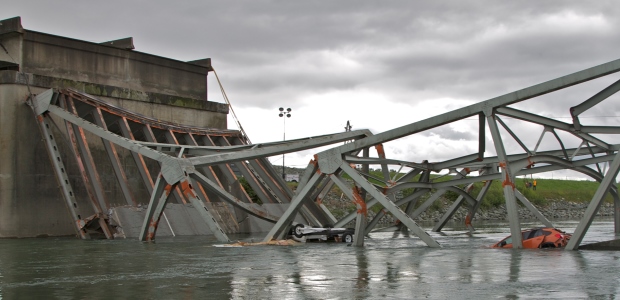
Washington State Patrol Cites Trucker in Skagit River Bridge Collapse
Driver William D.W. Scott's truck was permitted to carry a load of no higher than 15 feet, 9 inches, but his load, a metal casing, measured 15 feet, 11 inches. The load struck 11 of the bridge's sway braces as the truck crossed the bridge.
The Washington State Patrol has released its report summarizing detectives' investigation of the May 23, 2013, collapse of one span of the I-5 Skagit River Bridge in Mount Vernon, Wash., after a truck crossing the bridge struck its superstructure. They determined the truck's load was 2 inches over height: Driver William D.W. Scott's truck was permitted to carry a load no taller than 15 feet, 9 inches, but his load, a metal casing, measured 15 feet, 11 inches. The load struck 11 of the bridge's sway braces as the truck crossed the bridge shortly after 7 p.m.
Scott's truck was following a pilot vehicle too closely, so even if the pilot vehicle's driver had alerted him about a clearance issue, he could not have avoided the contact, the report states. The bridge's northernmost span collapsed immediately behind Scott, and two passenger vehicles fell into the river. Fortunately, all three occupants were rescued by a Snohomish County Sheriff's Office marine patrol unit, and all of them have recovered from their injuries.
WSP said one fatality was related to the collapse: On May 31, 2013, WSP Trooper Sean O'Connell was killed while directing traffic at a detour around the scene.
Detectives determined that the pole carried by a pilot car hit the bridge structure, which should have triggered a warning. Scott, however, as the driver of an over-height load is the person legally responsible for safe transit, not the driver of any support vehicle or pilot car, according to the agency. Scott, from Alberta, Canada, was cited for Negligent Driving in the Second Degree, a traffic infraction carrying a fine of $550.
He should have steered to the center lane of the bridge, where the superstructure was higher and the load would not have made contact. But Scott told NTSB investigators he had moved to the right lane, where the superstructure was lower, because another tractor-trailer was passing him in the left lane and he felt "crowded."
The WSP Report of Investigation is available here.